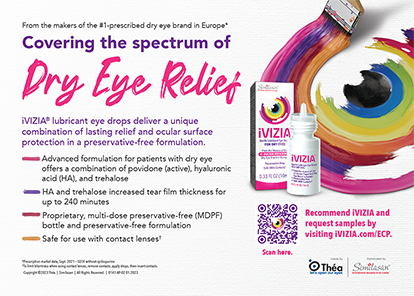
Eye care professionals who treat patients during the perioperative cataract surgery period are aware of the important role of topical medications, but at the same time, they likely also appreciate the limitations and difficulties that are inherent to their use.
Topical antibiotics help patients avoid vision-threatening infections, and topical nonsteroidal anti-inflammatory drugs (NSAIDs) and corticosteroids help to reduce inflammation that can slow the healing process and delay visual recovery. Although modern cataract surgery is minimally invasive and, therefore, likely to induce minimal inflammation, topical drop therapy still has a rationale. It is better to prevent postoperative inflammation such as cystoid macular edema (CME) than to treat it.
Ensuring effective delivery of perioperative topical medications on an appropriate schedule is challenging. Patients’ adherence to drop regimens is hindered by multiple factors. Recently, the possibility of using intracamerally administered combination medications at the time of surgery has emerged as a plausible means to deliver these medications while eliminating barriers to their use. Fixed-combination medications offer an opportunity to improve patients’ surgical experience.
This article discusses fixed-combination medications that are available for intraoperative use in the United States: the Dropless Cataract Surgery formulations from Imprimis Pharmaceuticals, and the combination mydriatic-NSAID Omidria (phenylephrine and ketorolac injection, 1.0%/0.3%; Omeros). Although these are the only such medications now available in the US market, this category promises to grow as the benefits of their use become apparent.
NO-DROP SURGERY
Imprimis offers two formulations of compounded medications that can be injected at the conclusion of cataract surgery: Tri-Moxi (triamcinolone acetonide and moxifloxacin HCl) and Tri-Moxi-Vanc (triamcinolone acetonide, moxifloxacin HCl, and vancomycin). Although these formulations are not approved for use during cataract surgery by the US Food and Drug Administration, each of the components of the compounded formulations is, and Imprimis pharmacies are accredited by the US Pharmacy Compounding Accreditation Board.
The two compounded formulations are designed to replace the need for topical medications to be administered by patients postoperatively. As simple as that sounds, removing the need to properly instill drops according to a potentially complicated schedule removes a major impediment to the use of these medications. Topical antibiotics, NSAIDs, and corticosteroids are, of course, most effective when they are applied correctly.
The availability of these so-called dropless products is relatively new, but the idea of using compounded medications in this fashion has been around for more than a decade. In a previous professional capacity, I worked with Kevin Scripture, MD, who was one of the early adopters of the concept in the early 2000s. Our clinic contracted with several compounding pharmacies to prepare products for use during cataract surgery; I have personal experience of collaborative care in more than 20,000 cases of no-drop surgery to date.
In my experience, no-drop cataract surgery streamlines the postoperative period for patient and provider: Patients’ need to comply with a regimen is eliminated, and the provider does not waste time and resources answering questions and dealing with insurance issues related to the topical therapies. One of the biggest reasons we adopted the no-drop approach, however, was that pharmaceutical companies stopped providing samples of perioperative topical drugs. This had the unintended effect of adding more out-of-pocket expense for patients. Even patients with insurance coverage can wind up paying $400 or more in copayments for these medications. Therefore, no-drop surgery became a means to ensure that patients were getting the drug coverage they needed without cost or practical burdens.
LISTEN UP
Gary Wörtz, MD, dissects the topic of dropless surgery with Drs. Bill Wiley and Mark Kontos.
Compliance and cost are obvious barriers to the use of medications in the postoperative period, but there may be additional hardships experienced by patients that providers do not consider. For example, I have had many patients tell me they did not want to burden family members or have to use care providers to help them administer their drops. Others have difficulties instilling the drops due to comorbid conditions such as arthritis. In addition, the use of multiple drops after surgery can cloud vision and slow down the recovery of acuity; for patients who are paying extra for a premium lens (and a premium experience), this can be a major concern.
Fixed formulations may not be appropriate for every patient. For example, their use in patients with a known fluoroquinolone allergy is contraindicated because of the inclusion of moxifloxacin. Also, some physicians are hesitant to use steroid-containing formulations in patients with moderate to advanced glaucoma. In my experience, however, postoperative IOP spikes are rare.
There is some concern that rates of CME may actually be higher after no-drop surgery due to insufficient coverage by the NSAID component. In previous experience using products from various compounding pharmacies, prior to the availability of the Imprimis products, we experienced different rates of CME depending on which compounding pharmacy produced the batch (unpublished data). This variability would suggest that the risk of CME is somewhat dependent on the source of the compound and not necessarily associated with use of the compounded formulation itself.
I was involved in a prospective study in which we performed optical coherence tomography imaging at baseline and again 3 months after surgery to assess CME. We enrolled 200 patients; 100 underwent no-drop surgery, and 100 used topical drugs postoperatively. We did not observe any noticeable difference in rates of CME in the two groups (unpublished data).
MYDRIASIS AND PAIN REDUCTION
Part of the minimally invasive nature of modern cataract surgery is the use of the femtosecond laser to fragment the cataract, reducing the need for ultrasound energy. Theoretically, this leads to less turbulence and energy delivery to the eye, each of which could instigate an inflammatory response. The potential for postoperative inflammation cannot be removed completely, despite the best efforts of the surgeon and the techniques he or she uses.
Omidria is a surgical adjunct added to the irrigation solution and infused through the irrigation line during cataract surgery, thus available to the intraocular structures throughout the procedure. The phenylephrine component is intended to maintain pupil dilation and prevent miosis. Preserving pupil dilation allows the surgeon to more easily perform intraocular maneuvers. Therefore, this component of the compound has an indirect effect on the safety of the procedure.
The NSAID component, ketorolac, is a prostaglandin inhibitor that contributes to the prevention of miosis and also helps to reduce postoperative pain. In a phase 3 clinical trial, this fixed combination outperformed placebo in preventing miosis and controlling patient-reported pain.1 Administered intracamerally, the drug may also inhibit the activity of inflammatory mediators throughout the ocular anatomy (retina, cornea, sclera, vitreous, choroid, lens capsule, ciliary body, and iris), thus potentially providing protection against retinal inflammation.2
CONCLUSION
The category of compounded medications used during surgery represents a relatively new drug delivery strategy. In the future, external reservoirs, drug-eluting contact lenses, or other devices may play a role in delivering the medications patients need during the postoperative period. For now and the foreseeable future, however, the options discussed herein provide a rational means of enhancing the efficacy of drug delivery.
Noncompliance with a postoperative regimen can occur for many reasons. Patients may be unwilling or unable to pay out of pocket for the drugs or the copayment. Forgetfulness can play a role, especially given the complexity of using up to three drops, potentially with different administration times during the day. Physical inability may inhibit delivery of the desired dose to the ocular surface. Whatever the reason, when patients are unable to use topical therapy as instructed during the postoperative period, there is an increased risk of complications. Fixed-combination medications instilled during surgery are a mechanism to streamline postoperative care, reduce costs, and take the burden of instilling drops away from the patient.
In my experience, no-drop cataract surgery is a significant upgrade over asking patients to self-administer topical antibiotics, NSAIDs, and corticosteroids. The techniques for their use are not difficult, and these products are fairly easy to incorporate into practice. In the setting of premium IOLs, when patients are expecting a premium experience, any step the eye care team can take to reduce postoperative burden is an asset. Frankly, all patients, even those who do not pay the additional charges associated with multifocal or toric IOLs, deserve the best chance of achieving a positive outcome.
1. Hovanesian JA, Sheppard JD, Trattler WB, et al. Intracameral phenylephrine and ketorolac (OMS302) during cataract surgery maintains intraoperative mydriasis and reduces postoperative ocular pain–integrated results from two pivotal phase 3 studies. J Cataract Refract Surg. 2015;41(10):2060-2068.
2. Florio V, Cowan L, Prusakiewicz JJ, et al. Ocular tissue distribution of ketorolac after administration of OMS302 to dogs during IOL replacement. Poster presented at: 2015 ASCRS-ASOA Symposium and Congress; April 17-21, 2015; San Diego, CA.
Richard B. Mangan, OD, FAAO
• private practice in Lexington, Kentucky
• eyeam4uk@gmail.com
• financial interest: none acknowledged



